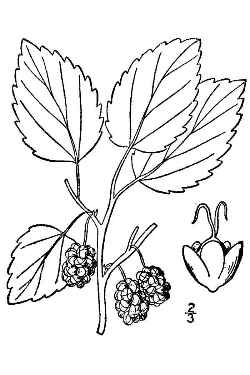
Britton, N.L., and A. Brown. 1913. Illustrated flora of the northern states and Canada. Vol. 1: 631.
Sunset®: All zones
USDA: 5-10
Sun Exposure: Full sun
Origin: China, Japan
Growth Habits: Small to medium-sized tree, 20 to 50 feet tall and wide (6-15 m);light grey trunk; the light green leaves are 2 to 5 inches long (5-12.5 cm), 3 to 6 inches wide (7.5-15 cm); 'Stribling' has maple-shaped leaves
Flowers: Greenish flowers
Watering Needs: Regular water
Propagation: Seeds, cuttings, or graftings
Propagation: Cutting or occasionally seed, grafting/budding
- by hardwood secondary cuttings, in spring. Apply IBA Quick Dip 12000 PPM. Use intermittent mist. It could be propagated by root cuttings in the spring..
- by whip, 'T' grafts, in early spring. Use a Morus alba tatarica as graftstock.
- by seeds, in spring. The seeds can be harvested in summer. The seeds need stratify 40F 2-3mo..
Trees are extensively grown (e.g. southern Europe, India) for their leaves as food for silkworms. The leaves can also be used as vegetable.
The mulberry can have a very attractive shape as a moderate size tree. Unfortunately the practice of cutting the branches back to the main trunk leaves it difformed, not reaching its potential, just give it a chance!
Mulberry pollen is an allergen, particularly in desert climates, and because of that, the sale of that tree is restricted in a number of locations.
Blooming Habits:
The white mulberry is dioecious (occasionally monoecious), male and female catkins are 1 to 3 inches long (2.5 to 7.5 cm) in early spring, the male flowers being narrower.
Fruiting Habits:
White, pink or purple drupes, 0.5 inch (1.3 cm) long, in early summer. The unripe fruits shouldn't be eaten as, like the mulberry sap, slightly toxic. The fruits may be eaten raw or cooked, but for most mulberry encountered in the trade in the US, the fruits are inferior, suitable only for birds. The fruits can be a nuisance when the tree is placed over concrete surface can be stained by the falling fruits.
Desert-Tropicals is dedicated to provide gardening advice, gardening ideas, and information about flower of all kind for landscape and collections.We try to check carefully the identification of the plants on the illustrations as well as the other information from the page, but occasionally errors do occur. if you notice anything that needs to be changed please contact us.Thanks.
© 1998-2020 Philippe Faucon, All Rights Reserved.